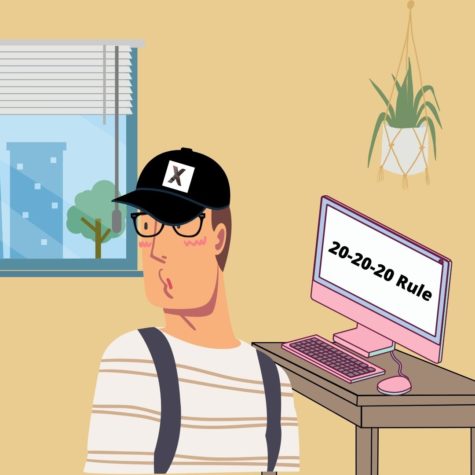It was the end of the fall 2021 semester and all Harmony Hernandez wanted to do was relax by playing video games.
The fourth-year political science major just finished two days’ worth of final assignments which she estimated to consist of 10 hours of screen time per day.
Hernandez’s game of choice was “Call of Duty Warzone” and she was only a couple of matches in until she started to feel the discomfort.
She noticed her eyes were unusually dry and started to hurt.
“I looked over to my mirror and my eyes were just red,” Hernandez said. “It was absolutely terrible.”
Eyestrain is described as any discomfort in and around the eye, Erin Rueff, chief of Stein Family Cornea & Contact Lens Center at Marshall B. Ketchum University said.
According to Mayo Clinic, a nonprofit organization dedicated to health research and education, eyestrain is a term used to describe conditions related to dryness, ocular disease, fatigue and other causes.
When it comes to computer eyestrain, Rueff said most people experience the symptoms of headaches, a pulling or tugging sensation in and around the eyes and soreness.
Hernandez said her eyes hurt so much that closing them was the only way to feel relief. Then, she left to go to Target to purchase eyedrops.
“I could not for the life of me look at a screen in any way, shape or form,” she said.
Rueff calls eyedrops “artificial tears” and advises people to stay away from the ones marketed to “get the red out.” She said those specific eyedrops usually contain an ingredient that turns the eyes even redder after the effects wear off.
“Right now it’s unavoidable for us to have to do a lot of work on our computers and our devices,” Rueff said. “So just being cognizant of the fact that you know, we just need a break.”
However, for Lila Hunter, a third-year graphic design major, extensively looking at a digital screen has been part of her routine even before the pandemic.
Hunter works with digital art and her screen has to be set on a particular brightness and be in an optimal setting to accurately display colors.
Her graphic design projects require immense fixation on the computer screen which has given her headaches.
Hunter has to work with subtle shades of colors and after staring at a screen for so long, they become hard to discern.
“I’m working on a product for hours and then I’m like, ‘colors just don’t make sense to my eyes anymore’,” Hunter said. “I need to take a break.”
Dr. Silvia Han, assistant professor of Pediatric Vision Care and Vision Therapy at Marshall B. Ketchum University said that it is important to take visual breaks.
“I recommend everyone, including myself to follow the 20-20-20 rule,” Han said. “Every 20 minutes, take a 20-second break by looking 20 feet far away.”

In Han’s department, they look at the eye-teaming, eye-focusing, and eye-tracking skills that factor into nearsighted activities.
“Those three skills are important to provide clear and comfortable vision while reading and doing close work,” Han said.
Close work is not exclusive to the computer, many of Han’s patients have experienced eyestrain by reading or studying without the use of a screen.
“Some people experience eyestrain–eye fatigue after just a whole day of work,” Han said. “They say they experience eyestrain every day after 6 to 10 hours of near work.”
Rueff said in the past couple of years people have complained about the discomfort of “digital fatigue” that could be caused by many conditions.
“It’s important to seek eye care if [eye strain] symptoms are really bothersome,” Rueff said.
Rueff said an optometrist checks for two things.
First, they check a patient’s vision to make sure they can see 20/20. If not, they either prescribe them glasses or update their prescription to make sure their vision is optimal.
They will also check a patient’s ocular health to see if they have any eye conditions or ocular diseases that the patient may not be aware of.
“It’s important to get that annual eye exam and make sure you’re getting your eyes checked,” Rueff said. “To make sure there’s not something that’s getting overlooked–no pun intended.”
Ketchum Health’s University Eye Center offers a 50% discount on eye exams when college students show their school I.D. card. For more information, contact the clinic at (714) 463-7500.




